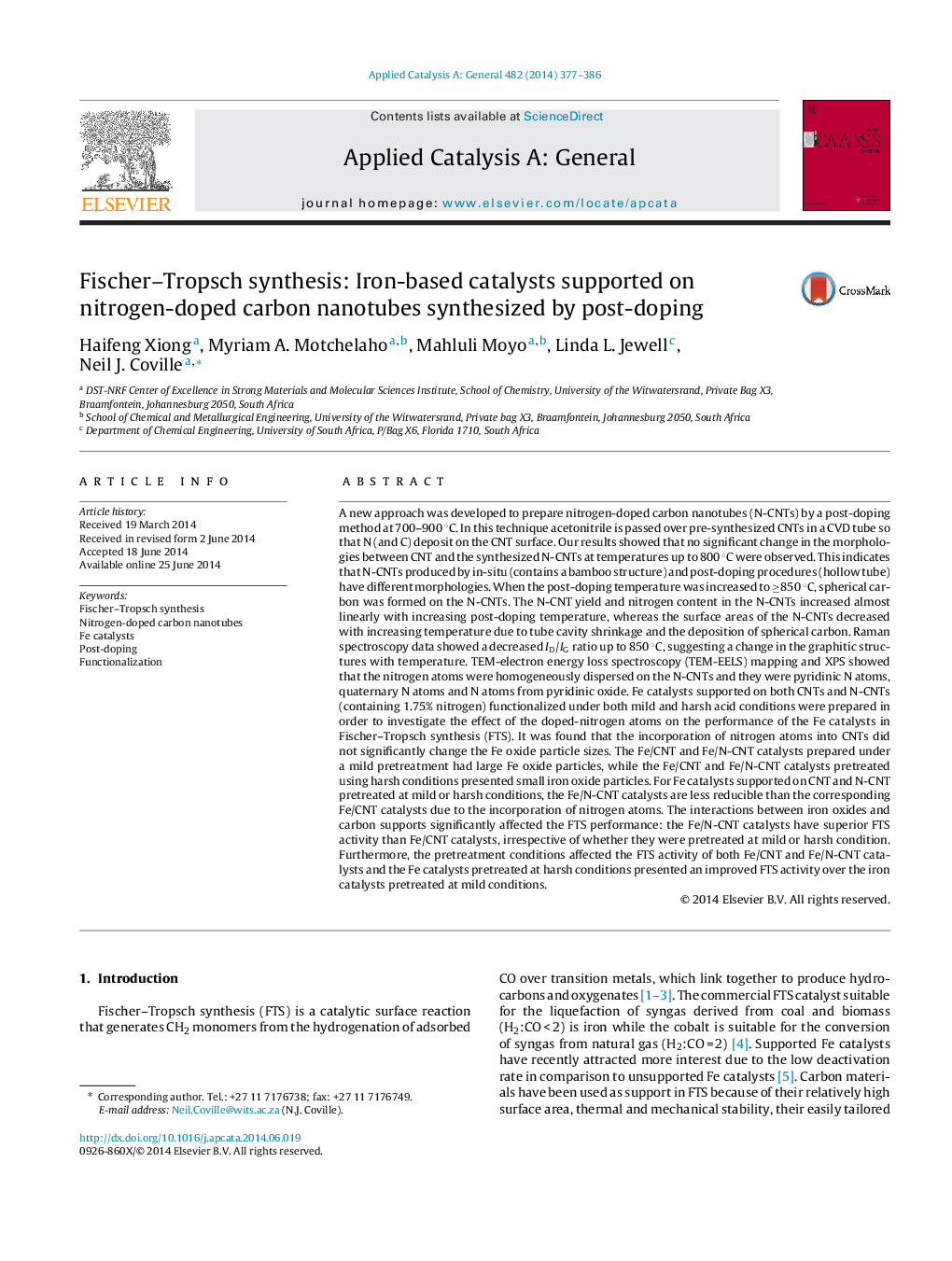| کد مقاله | کد نشریه | سال انتشار | مقاله انگلیسی | نسخه تمام متن |
|---|---|---|---|---|
| 39622 | 45828 | 2014 | 10 صفحه PDF | دانلود رایگان |

• N-doped CNTs have been made by a post-doping procedure.
• The N-CNTs have been made with different N contents.
• Acid washed CNTs and N-CNTs were studied for Fe catalysed Fischer–Tropsch synthesis.
• The acid washing procedure was found to determine the Fe particle size.
• The N doping was found to enhance the Fe FT activity.
A new approach was developed to prepare nitrogen-doped carbon nanotubes (N-CNTs) by a post-doping method at 700–900 °C. In this technique acetonitrile is passed over pre-synthesized CNTs in a CVD tube so that N (and C) deposit on the CNT surface. Our results showed that no significant change in the morphologies between CNT and the synthesized N-CNTs at temperatures up to 800 °C were observed. This indicates that N-CNTs produced by in-situ (contains a bamboo structure) and post-doping procedures (hollow tube) have different morphologies. When the post-doping temperature was increased to ≥850 °C, spherical carbon was formed on the N-CNTs. The N-CNT yield and nitrogen content in the N-CNTs increased almost linearly with increasing post-doping temperature, whereas the surface areas of the N-CNTs decreased with increasing temperature due to tube cavity shrinkage and the deposition of spherical carbon. Raman spectroscopy data showed a decreased ID/IG ratio up to 850 °C, suggesting a change in the graphitic structures with temperature. TEM-electron energy loss spectroscopy (TEM-EELS) mapping and XPS showed that the nitrogen atoms were homogeneously dispersed on the N-CNTs and they were pyridinic N atoms, quaternary N atoms and N atoms from pyridinic oxide. Fe catalysts supported on both CNTs and N-CNTs (containing 1.75% nitrogen) functionalized under both mild and harsh acid conditions were prepared in order to investigate the effect of the doped-nitrogen atoms on the performance of the Fe catalysts in Fischer–Tropsch synthesis (FTS). It was found that the incorporation of nitrogen atoms into CNTs did not significantly change the Fe oxide particle sizes. The Fe/CNT and Fe/N-CNT catalysts prepared under a mild pretreatment had large Fe oxide particles, while the Fe/CNT and Fe/N-CNT catalysts pretreated using harsh conditions presented small iron oxide particles. For Fe catalysts supported on CNT and N-CNT pretreated at mild or harsh conditions, the Fe/N-CNT catalysts are less reducible than the corresponding Fe/CNT catalysts due to the incorporation of nitrogen atoms. The interactions between iron oxides and carbon supports significantly affected the FTS performance: the Fe/N-CNT catalysts have superior FTS activity than Fe/CNT catalysts, irrespective of whether they were pretreated at mild or harsh condition. Furthermore, the pretreatment conditions affected the FTS activity of both Fe/CNT and Fe/N-CNT catalysts and the Fe catalysts pretreated at harsh conditions presented an improved FTS activity over the iron catalysts pretreated at mild conditions.
Figure optionsDownload high-quality image (220 K)Download as PowerPoint slide
Journal: Applied Catalysis A: General - Volume 482, 22 July 2014, Pages 377–386